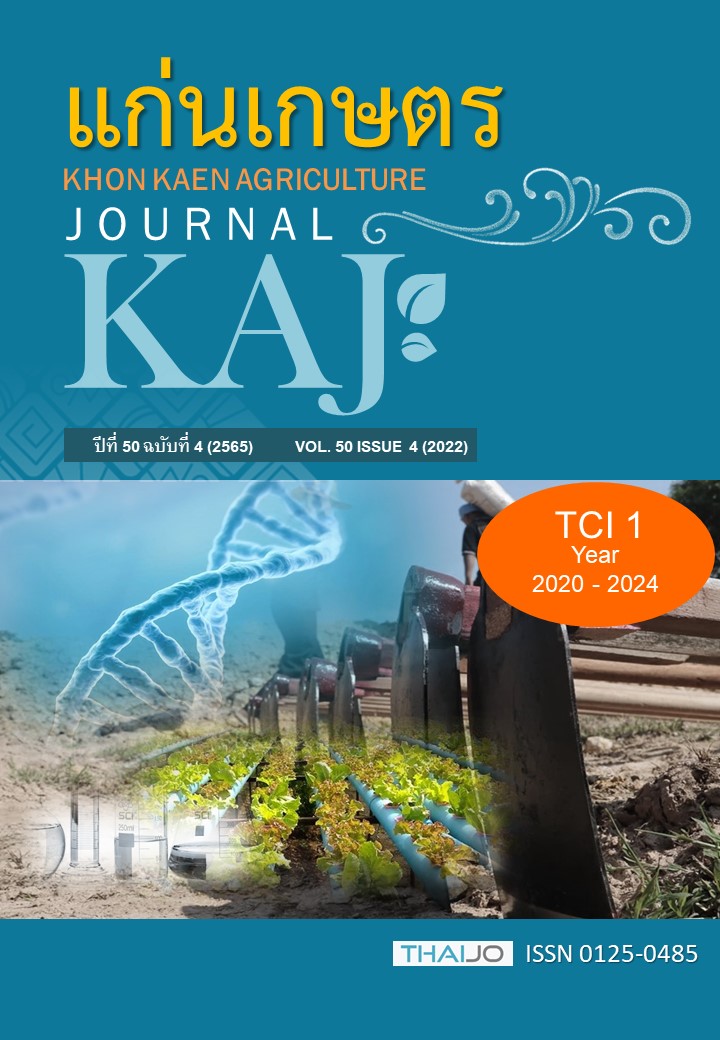อิทธิพลของปุ๋ยอินทรีย์และปุ๋ยเคมีต่อการเจริญเติบโต ผลผลิต และสารต้านอนุมูลอิสระในข้าวเหนียวดำ
Main Article Content
บทคัดย่อ
การศึกษาอิทธิพลของการใช้ปุ๋ยอินทรีย์และปุ๋ยเคมีต่อการเจริญเติบโต องค์ประกอบผลผลิต และสารต้านอนุมูลอิสระในข้าวเหนียวดำ ปลูกในสภาพเรือนทดลองโดยวางแผนการทดลองแบบ factorial in randomized complete block design มี 4 ซ้ำ โดยมี 2 ปัจจัย คือปัจจัย A ได้แก่ ข้าวเหนียวดำ 2 พันธุ์ และปัจจัย B ได้แก่ 5 วิธีใส่ปุ๋ย ผลการทดลองพบว่าข้าวก่ำเทพนามีน้ำหนักลำต้น จำนวนเมล็ดต่อรวง ความยาวราก ปริมาณสารแอนโทไซยานิน และความสามารถในการต้านอนุมูลอิสระมากกว่าข้าวก่ำไร่ แต่อย่างไรก็ตามข้าวก่ำไร่มีความสูงของลำต้น จำนวนรวง และน้ำหนักเมล็ดมากกว่าข้าวก่ำเทพนา สำหรับผลของการใช้ปุ๋ยพบว่าการใช้ปุ๋ยอินทรีย์เพียงอย่างเดียวมีแนวโน้มให้ข้าวเหนียวดำทั้งสองสายพันธุ์มีน้ำหนักลำต้น จำนวนรวงมากขึ้น และทำให้มีปริมาณสารฟีนอลิกมากที่สุดอีกด้วย นอกจากนี้การใช้ปุ๋ยเคมีร่วมกับปุ๋ยอินทรีย์ส่งผลให้ข้าวมีความสูงของลำต้นและจำนวนเมล็ดเพิ่มขึ้น โดยเฉพาะอย่างยิ่งปุ๋ยเคมี25%+น้ำหมักชีวภาพ25%+ปุ๋ยอินทรีย์50% ทำให้จำนวนเมล็ดและน้ำหนักเมล็ดมากกว่าปุ๋ยอื่นๆ และปุ๋ยเคมี50%+ปุ๋ยอินทรีย์50% ทำให้ข้าวเหนียวดำทั้งสองสายพันธุ์มีปริมาณสารแอนโธไซยานินและความสามารถในการต้านอนุมูลอิสระมากกว่าปุ๋ยอื่นๆ นอกจากนี้ข้าวที่ได้รับปุ๋ยอินทรีย์50%+น้ำหมักชีวภาพ50% ยังผลิตสารฟีนอลิกและผลผลิตได้มากที่สุด
Article Details

อนุญาตภายใต้เงื่อนไข Creative Commons Attribution-NonCommercial-NoDerivatives 4.0 International License.
เอกสารอ้างอิง
พัชราภรณ์ รัตนธรรม. 2556. สารประกอบฟีนอลิก แอนโทไซยานิน และสมบัติการต้านอนุมูลอิสระของข้าวกล้องสีงอก. วิทยาศาสตร์เกษตร. 44(2): 441-444.
ระพีพรรณ ประจันตะเสน. 2562. ข้าวไทยหลากสีป้องกันโรคไม่ติดต่อเรื้อรัง (NCDs). วิจัยและพัฒนาสุขภาพ. 12(2): 182-188.
ราเชนทร์ วิสุทธิแพทย์ และศริรธรรม สิงห์โต. 2551. ปุ๋ยอินทรีย์ ปุ๋ยชีวภาพ ทางเลือกใหม่เพื่อการเกษตร. สถาบันวิจัยวิทยาศาสตร์และเทคโนโลยีแห่งประเทศไทย. กรุงเทพฯ.
ลิลลี่ กาวีต๊ะ, มาลี ณ นคร, ศรีสม สุวรรณวงศ์ และสุรียา ตันติวิวัฒน์. 2552. สรีรวิทยาของพืช (Plant Physiology). ภาควิชาพฤกษศาสตร์ คณะวิทยาศาสตร์ มหาวิทยาลัยเกษตรศาสตร์. กรุงเทพฯ.
วรรณภา ก๋าถ้วย, เบญจวรรณ ฤกษ์เกษม, ศันสนีย์ จำจด, ณัฏฐิณี ภัทรกุล และชนากานต์ เทโบลต์ พรมอุทัย. 2556. ผลของการจัดการปุ๋ยไนโตรเจนและน้ำต่อผลผลิตและปริมาณสารแอนโทไซยานินในข้าวเหนียวก่ำ 2 พันธุ. แก่นเกษตร. 41(4): 403-410.
สัญชัย ยอดมณี. 2552. คุณภาพของข้าวพื้นเมืองมีสีภาคใต้ของประเทศไทย. วิทยานิพนธ์ระดับ วิทยาศาสตร์มหาบัณฑิต สาขาวิทยาศาสตร์การอาหารและโภชนาการบัณฑิตวิทยาลัย มหาวิทยาลัยสงขลานครินทร์.
เสาวภา สิทธิโชคธรรม, ทวีศักดิ์ เตชะเกรียงไกร, พรรณธิภา ณ เชียงใหม่, ปราโมทย์ แพงคํา, มานะ กาญจนมณีเสถียร, เสาวภา เขียนงาม, ฌานิกา จันทสระ, ยุภา ปู่แตงอ่อน, อําพร แจ่มผล, พรทิพย์ พสุกมลเศรษฐ และกานต์สุดา วันจันทึก. 2560. ผลของการบารุงดินด้วยปุ๋ยอินทรีย์ต่อลักษณะทางกายภาพและสารต้านอนุมูลอิสระในข้าวไร่. น. 953-960. ใน: ประชุมทางวิชาการของมหาวิทยาลัยเกษตรศาสตร์ ครั้งที่ 55 วันที่ 31 มกราคม-3 กุมภาพันธ์ 2560. คณะเกษตรศาสตร์ มหาวิทยาลัยเกษตรศาสตร์,กรุงเทพฯ.
ศุจิรัตน์ สิทธิโรจน์. 2562. Blockchain เพื่อการตรวจสอบย้อนกลับสินค้าเกษตร: สินค้าข้าวอินทรีย์. พื้นเมือง. แหล่งข้อมูล: http://www.tpso.moc.go.th/th/node/10497. ค้นเมื่อ 11 มิถุนายน 2564.
Bronick, C.J., and R. Lal. 2005. Soil structure and management: a review. Geoderma. 124: 3–22.
Chen, P., W. Kuo, C. Chiang, H. Chiou, Y. Hsieh, and S. Chu. 2006. Black rice anthocy-anins inhibit cancer cells invasion via repressions of MMPs and u-PA expression. Chemico-Biological Interactions. 163: 218–229.
Dixon, R.A., and N.L. Paiva. 1995. Stress-induced phenylpropanoid metabolism. Plant Cell. 7: 1085.
Edward, T., A.F. Albergaria, O.U. Morais, and A. Paulino. 2020. The effect of water deficit stress on the composition of phenolic compounds in medicinal plants. South African Journal of Botany. 131: 12-17.
Gong, Y., X. Liu, W.H. He, H.G. Xu, F. Yuan, and Y.X. Gao. 2012. Investigation into the antioxidant activity and chemical composition of alcoholic extracts from defatted marigold (Tagetes erecta L.) residue. Fitoterapia. 83: 481-489.
Hopkins, D.W., and R.S. Shiel. 1996. Size and activity of soil microbial communities in long-Term experimental grassland plots treated with manure and inorganic fertilizers. Biology and Fertility of Soils. 22: 66-70.
Iqbal, S., M. I., Bhanger, and F. Anwar. 2005. Antioxidant properties and components of some commercially available varieties of rice bran in Pakistan. Food Chemistry. 93: 265-272.
Jannoura, R., R.G. Joergensen, and C. Bruns. 2014. Organic fertilizer effects on growth, crop yield, and soil microbial biomass indices in sole and intercropped peas and oats under organic farming conditions. European Journal of Agronomy. Part B. 52: 259–270.
Jun, Z., N. Tian, L. Jing, L. Qiang, F. Zhiying, H. Qiwei, Z. Ruifu, L. Rong, S. Biao, and S. Qirong. 2016. Effects of organic–inorganic compound fertilizer with reduced chemical fertilizer application on crop yields, soil biological activity and bacterial community structure in a rice–wheat cropping system. Applied Soil Ecology. 99: 1–12.
Kesarwani, A., P. Chiang, and S. Chen. 2014. Distribution of phenolic compounds and antioxidative activities of rice kernel and their relationships with agronomic practice. The Scientific World Journal. 61: 1-6.
Khaliq, A., M.K. Abbasi, and T. Hussain. 2006. Effects of integrated use of organic and inorganic nutrient sources with effective microorganisms (EM) on seed cotton yield in Pakistan. Bioresource Technology. 97: 967–972.
Likhitwitayawuid, K., A. Sornsute, B. Sritularak, and P. Ploypradith. 2006. Chemicaltransformations of oxyresveratrol (trans-2,4,3,5-tetrahydroxystilbene) into a potenttyrosinase inhibitor and a strong cytotoxicagent. Bioorganic & Medicinal Chemistry Letter. s16: 5650-5653.
Marinari, S., G. Masciandaro, B. Ceccanti, and S. Grego. 2000. Influence of organic mineral fertilizers on soil biological and physical properties. Bioresource Technology. 72: 9-17.
Melissa, W., and E. Marchesan. 2011. Phenolic Compounds and Antioxidant Activity of Rice. Brazilian Archives of Biology and Technology. 54: 371-377.
Natwalinkhol, S., L. Thunnop, B. Dheerawan, and U. Niramon. 2018. Physiochemical, Antioxidant Activities and Anthocyanin of Riceberry Rice from Different Locations in Thailand. Food and Applied Bioscience Journal. 6: 84–94.
Oszmianski, J., A. Wojdy, and J. Kolniak. 2009. Effect of L-ascorbic acid, sugar, pectin and freeze–thaw treatmenton polyphenol content of frozen strawberries LWT. Food Science and Technology. 42: 581–586.
Tian, S., K. Nakamura, and H. Kayahara. 2004. Analysis of phenolic compounds in white rice, brown rice, and germinated brown rice. Journal of Agricural and Food Chemistry. 52: 4808-4813.
Zhao, H., F. Yao, Y. Zhang, B. Xu, J. Yuan, Y. Hu, and X. Yin-long. 2007. Correlation Analysis of Rice Seed Setting Rate and Weight of 1000-Grain and Agro-Meteorology over the Middle and Lower Reaches of the Yangtze River. China Agricultural Sciences in China. 6(4): 430-436.
Zhou, Z., K. Robards, S. Helliwell, and C. Blanchard. 2004. The distribution of phenolic acids in rice. Food Chemistry. 87: 401-406.
Qi, Y., Baowu, W., C. Feng, H. Zhiliang, W. Xi, and G.L. Pengju. 2011. Comparison of anthocyanins and phenolics in organically and conventionally grown blueberries in selected cultivars. Food Chemistry. 125: 201-208.


